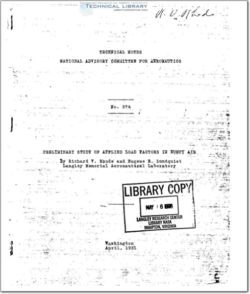naca-tn-374

- Version
- 162 Downloads
- 2.32 MB File Size
- 1 File Count
- April 23, 2016 Create Date
- April 23, 2016 Last Updated
National Advisory Committee for Aeronautics, Technical Notes - Preliminary Study of Applied Load Factors in Bumpy Air

The object of this note is to present the results, obtained
to date by the National Advisory Committee for Aeronautics, of a
study of accelerations or applied load factors experienced by
airplanes flying through “rough" or "bumpy" air.
Theoretical relations involved in the study are reviewed to
furnish a basis upon which the experimental data can be properly
analysed. The structure of the atmosphere in relation to the
loadefactor problem is briefly discussed, and the a-cceleration
data obtained on a number of flights with various airplanes are
presented and analyzed to the extent that the results are appli-
cable to any airplane.
From the study thus far, it appears that it will be possi-
ble to determine the proper design load factors for any airplane
in a rational way. However. so little is yet known of the struc-
ture of the atmosphere that the specific velocities of air cur-
rents indicated by the present data should not be construed as
the values to be adopted as a basis for design.
As any experienced airplane passenger knows. there are cer-
tain conditions under which an airplane is subjected to rather
abrupt shocks in the air. These shocks, which are commonly re-
ferred to as "bumps," are simply manifestations of more or less
abrupt changes in lift caused by changes in angle of attack and
drelative air speed as the airplane flies through an unsteady
atmosphere.
From the standpoint of the structural design of 'transport
or "nonacrobatic" airplanes, which never need be- subjected to
maneuvers more severe than the very mild turns. etct, required
to achieve a given destination, the "bumps“ experienced in fly—
ing through “rough“ air are of considerable importance. since
they give rise to the structural loads for which the wings
should be designed. In the past, practically no quantitative _
information on the structure of the atmosphere in its relations
to applied loads on the airplane has existed.--To supply-this.
deficiency, the National Advisory Committee for Aeronautics is
conducting an investigation of the accelerations obtained in
flight through rough air on a number of_transport airplanes fly—
ing regular scheduled trips. To date only a small amount of in-
formation has been obtained. However; enough has been accumu—
lated to throw considerable light on the subject of applied load
factors in rough air.
| File | Action |
|---|---|
| naca-tn-374 Preliminary Study of Applied Load Factors in Bumpy Air.pdf | Download |

Comment On This Post